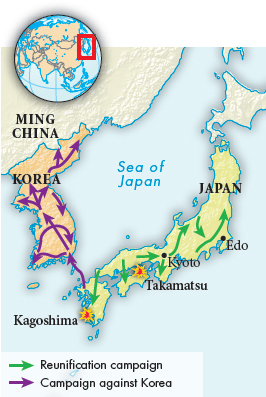Understanding World Societies:
Printed Page 625
The Victors: Nobunaga and Hideyoshi
The first daimyo to gain a predominance of power was Oda Nobunaga (1534–

In 1582, in an attempted coup, Nobunaga was forced by one of his vassals to commit suicide. His general and staunchest adherent, Toyotomi Hideyoshi (1537–
Like the Ming founder, Hideyoshi was a peasant’s son who rose to power through military talent. A series of campaigns brought all of Japan under Hideyoshi’s control. Hideyoshi soothed the vanquished daimyo as Nobunaga had done — with lands and military positions — but he also required them to swear allegiance and to obey him down to the smallest particular. For the first time in over two centuries, Japan had a single ruler.
Hideyoshi did his best to ensure that future peasants’ sons would not be able to rise as he had. His great sword hunt of 1588 collected weapons from farmers, who were no longer allowed to wear swords. Restrictions were also placed on samurai; they were prohibited from leaving their lord’s service or switching occupations. To improve tax collection, Hideyoshi ordered a survey of the entire country. His surveys not only tightened tax collection, but also registered each peasant household and tied the peasants to the land. With the country pacified, Hideyoshi embarked on an ill-
>QUICK REVIEW
Who held power during Japan’s Middle Ages? How did they wield it?